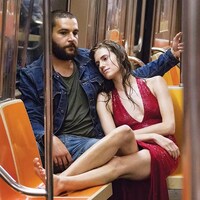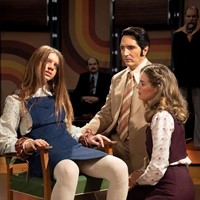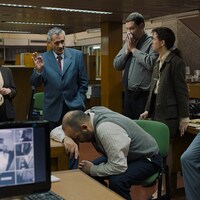In the wake of his passing, we revisit our 2011 interview with the legendary filmmaker, where he discusses directing in his twenties, Charles Manson, and the ‘remarkable’ Harry Potter films
At the age of 17, Kenneth Anger created the film Fireworks, which brought him international recognition as well as obscenity charges in the US. Throughout the 50s, 60s and 70s, Anger continued to push boundaries in the art of filmmaking with a series of short films, often with occult themes, which became known as the Magic Lantern Cycle. While working within the constraints of low budgets and the necessity of casting friends instead of actors, Anger created some of the most iconic images in the history of film. On film soundtracks, he collaborated with well-known pop stars such as Mick Jagger and Jimmy Page and cast such notable figures as Anaïs Nin, Marianne Faithfull and Donald Cammell.
With his notorious Hollywood Babylon series of books, Anger became known as a first-hand authority on the sleazy and depraved side of Hollywood and the secrets of its early stars. As a personality, Anger is often combative and was known to place very public curses on his enemies. Now, over six decades since he made his first film, Anger remains a creative force – making films, travelling extensively and occasionally performing with his avant-garde noise band, Technicolor Skull. Recently, Anger has also been making waves in the art and fashion worlds with an exhibition at New York’s MoMA PS1 and collaborations with the fashion houses of Valentino and Missoni. Anger’s recent films express his fascination du jour – war and related themes, through the use of archival footage edited with his unmistakable touch.
Dazed is celebrating its 20th birthday. With that in mind, what do you remember about being 20?
Kenneth Anger: I remember that I had just finished a short avant-garde film called Fireworks, and
I was really pleased with it. I made it on 16mm and I heard that Jean Cocteau was going to be a judge at the Festival du Film Maudit in Biarritz, France and so I just sent it off, and a little while later I found out it was awarded the prize for poetic film – that was in 1949.
What were you inspired by at that time?
Kenneth Anger: Well, I liked the films of Cocteau and some of the experimental work of Buñuel and I just wanted to make some personal films that were in that vein. I call them cine-poems – they are not narrative films but rather, stories told in pictures.
What inspired Fireworks?
Kenneth Anger: It was inspired by an incident at the end of WWII when a bunch of sailors in their sailor whites came up from Long Beach and proceeded to hunt down Mexican kids in downtown Los Angeles and beat them bloody. The incident is known as the Zoot Suit Riots because the Mexicans were wearing those fanciful zoot suits, you know – cut very weirdly and in outrageous colours like purple. That was actually the inspiration for Fireworks.
Looking back at your career, what are your most memorable times?
Kenneth Anger: I think the reception I had for Scorpio Rising in the 60s. It vindicated my approach to making a film scored with pop music. And the reaction to the film was good.
What films are you most proud of?
Kenneth Anger: I think my film Eaux D’Artifice is a perfect film. Fortunately, I was given permission to shoot in the garden of the Villa d’Este in Tivoli, Italy. I’m amazed that they gave me permission actually, but they did, because I was just, like, a teenager... no, well, very young at the time. But they seemed to like it and I was able to shoot in there without any restrictions.
Why do you consider it a perfect film?
Kenneth Anger: Because it fitted together perfectly – I used the music of Vivaldi’s “The Four Seasons”, and the two things just meshed together really well.
There’s some very interesting use of scale in that film...
Kenneth Anger: I was inspired by the Italian etchings of Giovanni Battista Piranesi, who did sketches of the ruins of the Roman Forum and also of the Villa d’Este in Tivoli but he made everything seem much larger by putting very small figures in… The figures were actually, like, child-sized, but it made everything seem that much bigger. So for my film, I found a little midget woman who was a friend of Fellini’s... so she worked with me. So she is the human scale, but she was actually very short, like, three-and-a-half feet tall.
What’s another film that you are proud of?
Kenneth Anger: I am pretty proud of Inauguration of The Pleasure Dome, which centres around a very deliberate kind of decadent aesthetic. It was inspired by the poems of Aleister Crowley.
What is it about that particular film that you are proud of?
Kenneth Anger: I think I captured the mood and aesthetic of Crowley. Largely, through the use of colour.
Lucifer Rising took over ten years to complete. What were some of the obstacles you encountered with that production?
Kenneth Anger: I had a hard time nailing down the character. The actor that was going to portray Lucifer... I lost a few of them along the way and eventually I found someone that I felt was adequate. Aside from that, it was just a matter of scraping together the money to make it. I did get a grant from one of the foundations – that helped.
Who were some of the Lucifers that didn’t make it into the film?
Kenneth Anger: There were people that for one reason or another... Well, like Bobby Beausoleil. I don’t want to go into that story, but... he went off and met Charles Manson and became a killer. [Laughs] You know... He was really young and all those kids were stoning themselves on LSD all the time. But he’s still locked up, and he deserves to be, because he killed someone.
What are you thoughts on Hollywood and contemporary cinema?
Kenneth Anger: As usual, there are a few people doing interesting work. I am more interested in the ones that can pull off something without spending huge amounts of money. I watch movies and some of them are pretty remarkable, at least the visual aspects, and the special effects. The Harry Potter films, for instance – I always check those out.
You are an inspiration to many creative people. What or who do you find inspiring right now?
Kenneth Anger: Well, in general, I pay attention to what people are doing. With commercial films, I respect the work of Martin Scorsese. I always look forward to seeing his new films. He is a great director, but I wouldn’t say he inspires my work directly.
Making a film is not like writing a poem. For writing, all you need is a pencil and a piece of paper, but for even a short film you have to have financing, have the means to make it, and whenever I can find the means to make a film, I make one. But chasing after the money... my films are basically non-commercial. But I’ve found various people who have helped me over the years. My best patron was Sir Paul Getty. And I have a current patron, a French businesswoman – her name is Agnès B.
“I watch movies and some of them are pretty remarkable, at least the visual aspects, and the special effects. The Harry Potter films, for instance – I always check those out”
Recently, there has been an increased interest in your work in the fashion world. How do you feel about that?
Kenneth Anger: Basically, I am delighted to have that interest. I’ve done some work for Valentino and Missoni. I even made a short film for Missoni. It’s one kind of commercial work that verges on the artistic.
What are you currently working on?
Kenneth Anger: I just finished a film about airships, which is simply called Airship, using newsreel footage and so forth. I am working on another project, the theme of which is warfare.
Are we ever going to get to read Hollywood Babylon III?
Kenneth Anger: It exists in rough form but I can’t publish it because it involves certain personalities like Tom Cruise who would sue me, even though the material is very carefully checked out and verified. He and a handful of others, not many, a select bunch, consider themselves Scientologists and Scientologists love to sue people!
Brian Butler is an artist, filmmaker and writer living in Los Angeles. He often collaborates with Kenneth Anger on projects such as the ritual noise performance Technicolor Skull
Dazed & Confused's October issue, 'Come Together: 20th Anniversary Special', is out now. Click HERE to check out the other, already published, Q&As celebrating the issue




